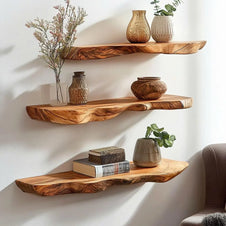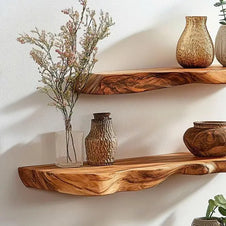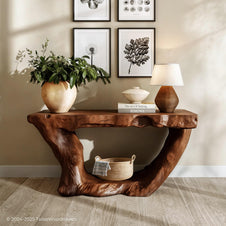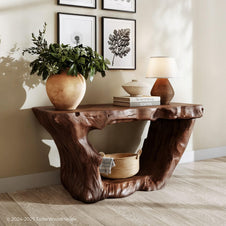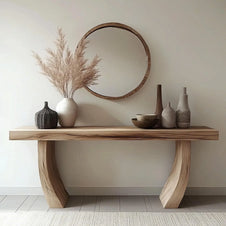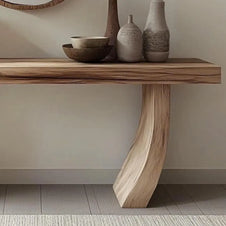Floating shelves are a popular alternative to traditional upper cabinets in a kitchen, adding an open, modern, and airy feel to the space. But once they're installed, the question remains: what to put on floating shelves in kitchen to make them look both beautiful and functional? The key is to find a balance between everyday practicality and stylish display. This comprehensive guide will show you how to curate your shelves, turning a simple storage solution into a stunning focal point.
The Styling Principles
Before selecting a single item, mastering a few core styling principles will ensure your shelves look intentional, not accidental. Understanding these rules is essential to figuring out what to put on floating shelves in kitchen successfully.
-
Rule of Three: Arrange items in odd-numbered groupings (e.g., three small canisters, five mugs). This simple trick makes any arrangement feel more intentional.
-
Create Visual Triangles: Within each grouping, arrange items of varying heights in a triangular shape. For instance, place a tall vase behind a medium-sized frame and a short candle in front. This guides the eye through the display and adds a dynamic, professional look.
-
Mix Heights and Textures: Use a combination of tall and short items (e.g., a tall vase next to a short stack of bowls) and different textures (e.g., smooth ceramics with a woven basket or a wooden element). This contrast adds depth and richness to the overall display.
-
Leave Breathing Room: This is arguably the most crucial principle when deciding what to put on floating shelves in kitchen. Do not overload the shelves. Leaving open space around your groupings allows the eye to rest and emphasizes the items you have chosen, achieving a clean, curated aesthetic.
To instantly master the "Mix Heights and Textures" rule and give your display a dynamic, organic focal point, anchor your kitchen arrangement with our live edge floating shelves.
Defining Shelf Purpose
To achieve the perfect balance between practical storage and beautiful display, you must first define the function of your shelves. This planning stage is critical in guiding your decisions about what to put on floating shelves in kitchen.
Daily Reach vs. Display Only
Separate high-touch items that you access every day (mugs, plates) from purely decorative pieces (art, vases). High-touch items should be placed at easily accessible heights. Display-only items can go higher, where they are seen but not constantly moved.
Creating Functional Zones
Think of your shelves in functional zones, which helps you decide what to put on floating shelves in kitchen that makes sense. Do you have a shelf designated for a coffee/tea station (mugs, sugar, filters)? A prep zone (oils, salt)? A baking zone (flour canisters, cookbooks)? Or a serving/bar zone (pitchers, glassware)? Defining the zone limits the choices and creates visual harmony.
Safety & Cleanability
Kitchens are messy places with heat, moisture, and grease. Because of this, you must choose decor that is easy to wipe clean and can handle temperature changes. Keep sensitive items like unsealed wood or paper away from the stove. These simple rules must guide what to put on floating shelves in kitchen.
What to Put Floating Shelves in Kitchen?
The most successful kitchen shelves prioritize practical items that look great. Displaying your most-used dishes not only frees up cabinet space but also ensures items are frequently washed, preventing dust buildup.
Plates, Bowls, and Mugs
The most common and practical answer to what to put on floating shelves in kitchen is dinnerware. Stack your plates and bowls by size, aiming for short, sturdy stacks of six to eight items. For visual interest, mix matching sets with a few unique pottery pieces, using color to tie them together. You can display favorite mugs by stacking them carefully or by hanging them from hooks beneath the shelf to save space.
Highlight your favorite pottery and dinnerware pieces against the rich, contrasting texture of our floating rustic wood shelves - the perfect sturdy foundation for a farmhouse-chic kitchen.
Glassware & Pitchers
Glassware adds a beautiful sparkle to the shelves, catching and reflecting kitchen lighting. Group drinking glasses by height and stack them no more than three high for stability. Display one or two attractive pitchers or carafes alongside them; their height helps create those essential visual triangles.
Cooking Oils, Salt Cellars, and Spices
When considering what to put on floating shelves in kitchen, everyday cooking supplies like oils and spices are ideal because they need to be within easy reach. To keep the look clean, decant cooking oils into attractive glass dispensers. For spices, store them in matching jars but place them away from direct sunlight or intense stove heat to preserve their flavor. Finally, use small, decorative trays or boards beneath these items to neatly group them and catch any potential drips.
Achieve the look of effortless organization: the clean lines of this floating wood shelf offers the sturdy, stylish access point you need for frequently used oils and spices.
Canisters for Dry Goods
Choosing the right canisters is key to functional kitchen styling. Use clear glass or consistent ceramic canisters with airtight lids to store flour, sugar, oats, or rice. Consistent labeling (e.g., using minimalist or uniform font) is crucial for a clean, organized look and is essential when deciding what to put on floating shelves in kitchen for pantry use.
Coffee & Tea Station
Dedicate a shelf to morning essentials. Arrange matching jars for sugar and coffee grounds, stack filters in a small dispenser, display your favorite mugs, and ensure there is enough vertical kettle clearance if the shelf is above your counter.
Personal Touches and Decorative Items
To avoid a sterile look, integrate decorative elements that reflect your style. This is the artful side of deciding what to put on floating shelves in kitchen.
-
Greenery: Greenery immediately adds life and color to your shelves. Choose low-mess, easy-to-care-for plants like succulents or pothos, but always use drip trays to prevent water damage. You can also use a line of fresh herbs for a beautiful and functional touch.
-
Cookbooks & Art: Cookbooks are a suitable answer to what to put on floating shelves in kitchen, as they add color, height, and texture. Display a few visually appealing books by leaning them or using a small bookend. Group them by size or spine color for a cohesive look, and make sure they are not too close to the stove's grease zone.
-
Artisan Pieces: Items like hand-thrown bowls, carved wooden boards, or small ceramic sculptures show that your display is deliberately curated. These unique touches are the perfect answer to what to put on floating shelves in kitchen.
-
Seasonal Swap: Keep your shelves fresh by swapping small elements for the season. This could involve changing the color of your textiles (dish towels), swapping out dried stems in a vase, or using different glaze colors of pottery to reflect the time of year.
Built to last in the kitchen environment, our natural wood floating shelves offer a sturdy, neutral canvas, ensuring your personal touches, from vibrant plants to colorful cookbooks, are the true focus of the display.
What Not to Put on Kitchen Shelves
Knowing what not to display is just as important as knowing what to put on floating shelves in kitchen.
-
Rarely Used Appliances: Avoid large, heavy appliances like food processors, which are visually busy and attract dust.
-
Tall Liquor Bottles Near Heat: Never store tall, heavy bottles near a stove, as heat damages the spirits and the tall shape can make the shelf unstable.
-
Original Packaging: Always decant food items (like flour or cereal) from paper bags and boxes into matching canisters to prevent an instantly cluttered look.
Common Mistakes to Avoid
Successfully styling your shelves hinges on avoiding these common errors:
-
Overloading: Don't crowd the shelves. The most frequent error when deciding what to put on floating shelves in kitchen is putting too many items on them, which makes the entire space look cluttered, chaotic, and defeats the purpose of open shelving.
-
Ignoring a Color Palette: All displayed items should share a consistent or complementary color palette. For example, stick to whites, grays, and woods, or use one accent color like blue or green to tie everything together.
-
Ignoring a Theme: All the items should fit a central theme, like "modern minimalist," "rustic farmhouse," or "colorful eclectic." Mixing too many different styles makes the shelves look disorganized.
-
Forgetting to Clean: Open shelving collects dust and grease easily. Regular cleaning (a quick wipe-down with a microfiber cloth every week) is a must to keep your display looking fresh and sanitary.
Conclusion
Figuring out what to put on floating shelves in kitchen is a fun and highly rewarding process that can transform your entire space. The goal is not just to store, but to showcase. By embracing the core principles of the Rule of Three, mixing functional essentials with personal decorative items, and maintaining a consistent theme, you can ensure your open shelves become the most admired feature of your kitchen. With these ideas on what to put on floating shelves in kitchen, you have everything you need to create a beautiful and intentional display that reflects your unique style and elevates your everyday cooking experience. For more ideas on decorating kitchen shelves, check out this guide from The Spruce.

